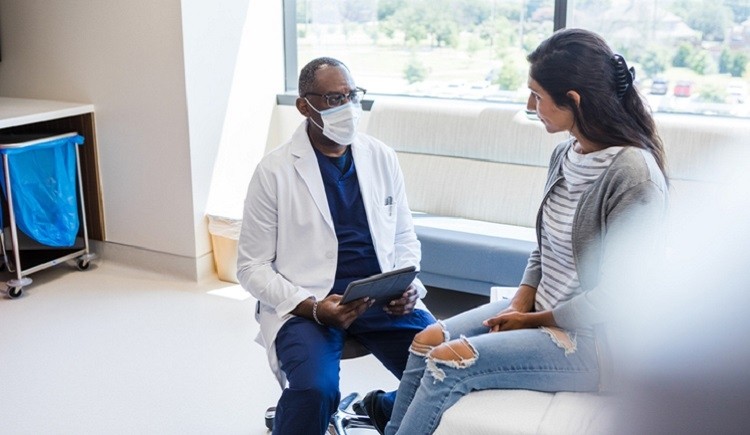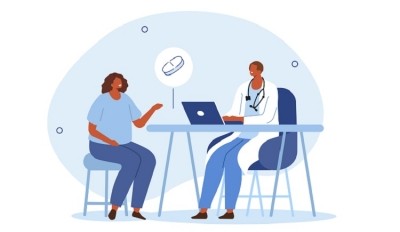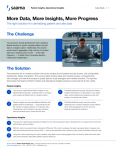Patient-centric approach benefits more than the patient: Quanticate

When patient centricity is a true goal and not just a buzzword, trial teams can realize a range of benefits. For starters, patients can feel more satisfied, which leads to increased compliance—and that can contribute to higher-quality data and better results.
To learn more about the myriad potential benefits of true patient centricity, Outsourcing-Pharma connected with Karen Ooms, joint chief operating officer of Quanticate.
OSP: Patient-centricity, as you point out, is growing in popularity, but what about how trial teams put it to work—are they better able to successfully design and execute patient-centric trials than in the past?
KO: There is no doubt that designing and successfully executing a trial that involves patient-centric elements is becoming more manageable and easier to execute. With drugmakers recognizing the value of patient-centricity, there is more scope to include elements that make the trial process more focused on the patients’ needs.
A significant part of the change that was required to realize this is through a shift in mentality: from the feasibility and ease with which the sponsor can conduct the study to the feasibility and ease with which a patient can go through the process.
One example of this is the growing use of adaptive trial design, which means that many elements of the study can change when predefined and specific rules are triggered. For example, if a treatment arm is found to be ineffective then it can be dropped, which allows patients to visit the clinic less frequently or even finish a trial earlier than expected. This flexibility is a significant aid to those involved in the trial, either by bringing them into a study where a treatment has been found to be particularly effective or by reducing exposure of patients to a treatment that is not efficacious.
That is not to say that the execution of patient-centric trials has been perfected, as there are still ongoing challenges that need to be addressed, but the process is vastly improved compared to just a few years ago.
OSP: What are some of the challenges and stumbling blocks around patient centricity that still exist?
KO: Though strides have been made to introduce more patient-centric measures into clinical trials, in a highly regulated space, there is a degree of caution with which new elements are introduced. This is for a very good reason, as the safety of patients is paramount.
The potential for technology to facilitate the communication of patients to those running the trials and the sponsors is huge. During the pandemic, we saw a dramatic increase in the use of such smart devices to improve communication and this progress must be maintained.
One of the key challenges to ensuring that patients continue to attend clinical trials is the travel to trial sites. It is not patient-centric to make them frequently visit trial sites when technological solutions can offer a solution, such as integrating with devices to provide notifications to complete questionnaires or diaries.
Associated with the need for technology to be adopted and, where adoption has already happened, maintained within the clinical trial process is the challenge of validating the data generated by smart devices. In a traditional trial, clinical trial data would be source verified on site.
However, now that collecting real-world evidence through technology is possible, source data verification for wearables or electronic clinical outcome assessment (eCOA) devices is becoming a matter of debate. Regulators are concerned about the lack of source data verification in this area. This is one obstacle that will need to be surmounted to gain the true patient-centric value of introducing smart devices into clinical trials.
OSP: Could you please tell us what is typically meant by patient centricity in a trial, and what considerations patient-centric trial design/execution entails?
KO: Patient-centricity in clinical trials can be understood as placing the needs of the patients as the primary driver behind decision-making and actions when thinking about a trial design and its execution. This includes all care delivered whilst the patients are receiving treatment as part of the trial, from delivery of the medicine to patient recruitment.
Increasingly, the process of patient-centricity is extending into the drug design process, where patients are being encouraged to outline the symptoms of their condition that they would like to be addressed.
In terms of the trials themselves, patient-centricity can be addressed through the structure of the trial, such as whether they are decentralized and whether they feature adaptive trial design. Patient-centricity can also be considered when looking at dosing of the treatment, where research is increased into lower doses of treatments to minimize toxicity whilst ensuring they are as effective as higher doses.
As previously mentioned, real-world evidence also holds the potential to make clinical trial design more patient-friendly, which leads to the potential for smart devices/technology to play an increasing role in the design of trials to do the same.
These are just some of the considerations that can be made to trial design and execution to make trials a better experience for the patient. There are many more options and with patient-centricity only set to become more foundational as time goes by, I would expect many more initiatives to develop that will make clinical trials more focused on the patient.
OSP: Please talk about how ensuring a high degree of patient centricity leads to a number of benefits (i.e. fewer missed visits and dropouts, improved data capture, and the like.
KO: One of the major reasons behind the shift toward patient-centricity in recent years is because it really represents a win-win situation for both the industry and the patient. For the patients, the benefits are that they feel more valued and respected for their contribution to the drug development process, which is crucial. Decentralized trials and smart devices that allow fewer visits to the clinical trial site remove or reduce a major burden for patients, in terms of travel.
For the industry, the benefits are huge: it goes without saying that making sure the patients have a positive experience ensures that the clinical trial can even continue. A major challenge that trials have is recruiting enough patients and, once the trial is running, retention. Patient-centricity makes those involved in the trial feel engaged with their treatment, with those working at the site, and with the whole process – greatly improving the chances that the patient will remain for the duration of the trial.
Further benefits for the trial are that there are fewer missed visits, clinical outcomes can be improved due to the greater collection of data being carried out and digital tools can provide prompts to ensure patients complete questionnaires and diaries. The same tools can also provide reminders to take treatments, which improves adherence to regimes.
All of these factors contribute to wider benefits for those running the trials, which is that it can reduce overall cost. Individuals dropping out of trials can lead to the trial becoming underpowered and the sample size becomes too small to draw accurate conclusions. Keeping patients happy and engaged may not entirely prevent this but it goes a long way toward helping.
OSP: Please talk about DCTs and the ways in which the format might make achieving patient-centricity easier (and, more difficult).
KO: During the height of the pandemic, decentralized trials became essential to ensure that a number of clinical trials could continue. The process of adopting or taking specific tools from DCTs will grow, as the experience during the pandemic proved that this trial design could work.
If patient-centricity is about making the patient feel as comfortable as possible and at the center of the process then shifting the location to their own home is a logical step. The traditional design of clinical trials, where there is one center that is highly controlled, will struggle to appeal to as many patients compared to when the trial comes to them.
The decentralized nature of the trial also allows for patients to participate where previously there may have been geographical barriers, such as being too far from a clinical trial site.
The advantages do not mean that there are not also drawbacks to this approach. Though DCTs can reduce geographical burdens, they also necessitate patients having digital literacy, with digital technology crucial to the collection of data. The use of smart devices now represents a broad section of the population but that does not mean everyone will feel comfortable or competent with such devices.
Another important aspect of DCTs that may pose a patient-centricity problem is the lack of in-person face-to-face time with experts. The time spent physically with nurses or the study team can often be reassuring for participants. but with the advance of technology, these can be minimized.
OSP: Please talk about the ins and outs of adaptive trial design.
KO: Perhaps it won’t come as a surprise from the name but adaptive trial design is an approach to clinical trials that is inherently more flexible than the traditional approach. Where traditional clinical trials are created with predetermined endpoints, adaptive trial designs allow for elements of the trial to be altered depending upon circumstances.
Trials with an adaptive design can be more efficient, informative, and ethical than the traditional approach since it is a reflexive approach. If a treatment is not working or the dosage is not working as intended then it is possible to abandon the trial.
A characteristic of adaptive trial design is that data analyses carried out during the trial can then be used to modify the trial. This is very different from traditional clinical trials, where it will run until completion, barring serious safety concerns.
The reason adaptive trial design may be more appealing than traditional trials is due to various factors: fewer patients may be required overall; underpowered trials are more likely to be prevented; the patients most likely to benefit may be identified; a conclusion may be reached on treatment efficacy earlier.
OSP: Then, could you please talk about the benefits of optimized dosing?
KO: The FDA’s Oncology Center of Excellence created Project Optimus as a way to encourage the reform of dose optimization and dose selection in oncology drug development. The aim was to reduce the number of patients who receive treatment for longer periods of time than necessary and at higher dose levels than necessary. If this can be achieved then fewer cases of toxicity or adverse side-effects may be reported and, as a result, patients may be more likely to continue in trials and to have a better overall experience. The tendency is currently to find the maximum tolerated dose in the hopes of this also being the dosage required to be the most effective to eradicate cancerous cells.
The change in strategy to optimized dosing is one driven by patient-centricity and a greater interest in the patient’s overall well-being. It is leading to more research being conducted on the efficacy of smaller doses. For its part, the FDA will encourage drug developers to meet with Oncology Review Divisions early into the drug development process to discuss dose-finding and dose optimization. The agency will also communicate its expectations through further guidance, workshops, and public meetings.
OSP: Also, please tell us about the use of technology to interact with patients and some of the challenges associated with it.
KO: The development of technology and the use of data have changed many industries, and the running of clinical trials is not any different. Technology offers so much potential in clinical trials because the entire trial process is centered on the capture of data, whether that be safety or efficacy data. Now, there is an opportunity for drug developers to use the momentum generated during the pandemic, in the greater reliance on technology, to make it a more intrinsic part of clinical trial design.
In terms of how technology is improving relations with participants of trials, the most obvious one is the way in which patients’ own devices can be harnessed to create engagement. Through smart devices and the ability to send notifications to these devices, patients can be reminded to complete diaries or questionnaires, which improves the ability to capture information about their experiences.
If key data can be generated through devices that can be worn at home and in regular life then the entire trial process becomes a more efficient system. Everyone benefits in this scenario, the trial organizer has fewer patients coming into sites, which reduces complexity, and patients spend less time traveling.
There are challenges that will have to be addressed. For instance, there will need to be increased education on the use of eCOA data, as well as how this data is used and managed. The industry will also need to determine how to integrate digital tools into the trial process smoothly while being inclusive to all patients. Once implemented, there will also need to be a solution to collecting data outside of a clinical trial setting and how the SDV can be made applicable to trials, as well as being recognized by regulators.
OSP: Do you have anything to add?
KO: One area that we haven’t covered is quality of life (QoL) endpoints, which is a growing development in the industry. Essentially, this is determining the efficacy of a therapy both to treat the targeted conditions but also potential benefits to the patient’s everyday life. This is an important development as patients can have differing views of what symptom of their condition is the most impactful on a day-to-day basis. The patients themselves are the individuals best placed to determine this and so the importance of consulting with them directly is of increasing importance.
To address this, patients need to be involved in the process through disease-specific questionnaires to measure and report on the QoL. To encourage this, the adoption of personal devices into the trial process, through a bring-your-own-device strategy, will increase compliance and improve the likelihood of capturing all relevant data.




















